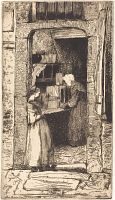Etchings Institutions search term: obach
La Marchande de Moutarde | ||
| Number: | 20 | |
| Date: | 1858 | |
| Medium: | etching | |
| Size: | 157 x 90 mm | |
| Signed: | 'Whistler' at lower left | |
| Inscribed: | 'Imp. Delatre. Rue St. Jacques. 171.' (2-3); crossed out (4); removed (5) | |
| Set/Publication: | 'French Set', 1858 | |
| No. of States: | 5 | |
| Known impressions: | 75 | |
| Catalogues: | K.22; M.22; T.11; W.16 | |
| Impressions taken from this plate (75) | ||
KEYWORD
TITLE
'La Marchande de Moutarde' (1858, Whistler). 2
'La Marchande de Moutarde' (1858/1870s, Whistler). 3
'La marchande de moutarde (Cologne)' (1859, Salon, Paris). 4
'La Marchande de Moutarde' (1874, Ralph Thomas, Jr (1840-1876)). 5
'An Old Woman' (1875, Cincinnati). 6
The addition of a place (Cologne) in the Salon catalogue is interesting, because the etching is based on a drawing entitled 'Marchand de Potions in Cologne'.
However, the original title, and that generally accepted by later cataloguers was 'La Marchande de Moutarde' which means 'The Mustard Seller'.
2: Douze eaux-fortes d'après Nature.
4: Paris Salon 1859 (cat. no. 3673).
5: Thomas 1874 (cat. no. 11).
6: Cincinnati 1875 (cat. no. 255).
DESCRIPTION
SITTER
7: Mansfield thought that the drawing was inscribed 'Marchand de Potions in Cologne' (Mansfield 1909).
SITE

La Marchande de Moutarde [m0273].
Freer Gallery of Art, Washington DC.
The etching was exhibited as 'La marchande de moutarde (Cologne)' in 1859. 8 The precise site has not been identified. Other etchings based on Whistler's Rhineland sketches include An Artist Sketching [23].
8: Paris Salon 1859 (cat. no. 3673).
DISCUSSION
9: Lochnan 1984 , pp. 46-47.


